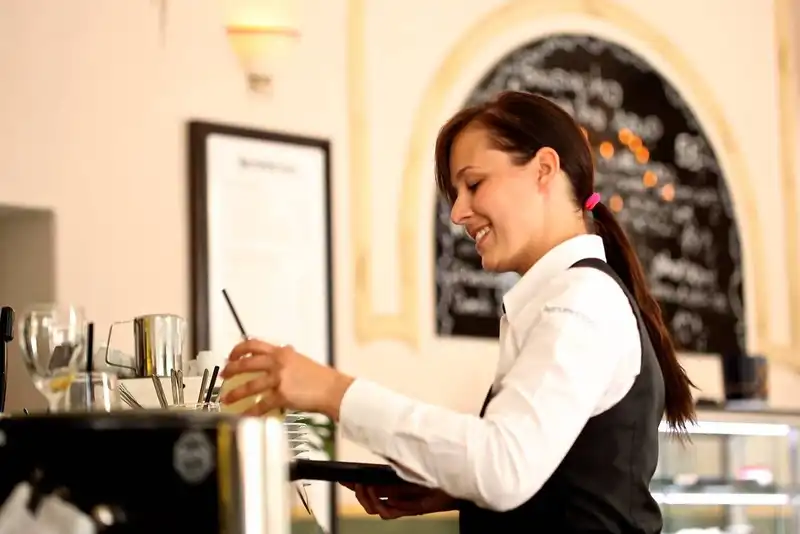A Crash Course on Employee Experience
What is Employee Experience?
Everyone wants to work for a company that cares about its workforce. While the bottom line and customer satisfaction are critical, owners can't forget about their team. One happy employee tends to make a great employee. A company full of happy employees leads to a more productive, efficient workforce. With higher morale comes everything from lower turnover to better customer relationships. But what exactly does this look like in the real world?
An employee experience is a concept that arose due to changing market trends. It includes the need to hire and attract valuable team members when there are limited options. This talent must be well-trained and engaged to increase efficiency and accelerate growth. Finally, a restaurant must support socially responsible core values and emphasize well-being.
Employee experience isn't just one of those business buzzwords. When employers prioritize the company culture, it has a real-world impact. Improving employee experience is what led to Airbnb's increase in value after only a few years on the scene. Just like Airbnb, every restaurant owner should take a hard look at every employee interaction. In learning more about these day-to-day communications, restaurants can optimize employee engagement.
The Importance of Employee Experience
Why is a good work experience so important? Furthermore, why is a business required to prioritize employee happiness? Isn't the whole point of running a restaurant to make money? While a restaurant certainly needs to create profit to exist, that profit doesn't just come out of nowhere.
Issues such as high turnover and absenteeism cut into profits and decrease the bottom line. A great employee experience impacts everything, including the amount of money a restaurant makes. Here is how employee experience matters in each sector of the business world.

Online employee scheduling software that makes shift planning effortless.
Start your free trial now. No credit card required.
1. Restaurants Benefit from a Good Employee Experience

High turnover cripples a restaurant. Hiring, onboarding, and training expenses are costly. When too many workers leave after a short time, the impact is devastating. It not only hurts financially, but it also impacts the company culture. It also hurts productivity levels because there is a constant need to train new team members. Finally, it creates a lot more work for HR leaders, who are usually swamped to begin with.
Engaged employees tend to stay employed longer. Most employers think workers leave for more money, but they leave because they don't like the culture. Moreover, engaged team members are much less likely to leave than disengaged ones. Therefore, prioritizing employee experience is beneficial from both a financial and morale standpoint.
2. Employees Benefit from a Good Employee Experience

Engaged employees tend to be more productive and creative. They feel comfortable in their roles and know there is room for advancement. They know that supervisors are available to listen and resolve bottlenecks. Happy team members can visualize their future work environment, and what they see is positive.
This increase in engagement lowers turnover, improves absenteeism, and increases morale. There is greater accountability for workers when they do something wrong, which improves productivity. Moreover, there is an incentive to do something right. This productivity pays off. Restaurants with happier team members are much more innovative and tend to grow faster.
3. Customers Benefit from a Good Employee Experience
When restaurants are more productive and employees are happier, customers notice. They get their food quickly and know that bad service is infrequent. Employees are polite and know to focus on the task at hand, which customers appreciate. Customers build relationships with long-term employees and managers. This generates a homey, traditional feel that many large restaurants with high turnover don't have.
Moreover, unhappy employees impact happy employees. If there are too many unhappy employees, a restaurant is less productive. This impacts everything from customer wait times to the quality of food to table turnover. It also decreases the ability to attract new customers or build brand awareness.

Restaurant marketing is complicated.
Learn everything you need to know with our free Digital Marketing for Restaurants ebook.
5 Benefits of a Positive Employee Experience
Every restaurant owner should ask himself how employees experience the workday. A positive employee experience stems from strong core values, good communication, and access to technology. It's only when employers prioritize these three areas that employees experience engagement.
Regularly monitoring and managing this experience creates a better company culture. This kind of culture is happy, productive, and efficient. Workers don't dread coming to work. They know that it is a culture they can succeed in. As a relatively new topic in Human Resources, owners may need to be convinced that a good employee experience is important. To ensure restaurants understand the benefits of a great employee experience, they must know these top benefits.
1. Employee Experience Benefit Happiness Improves Performance
When employees feel appreciated and happy at work, it creates a stronger work culture. It also positively impacts the restaurant's performance. To optimize productivity among team members, it's critical to maximize employee happiness.
This may require providing more benefits, investing in technologies, or hiring new management. Regular performance management processes such as surveys and reviews also improve employee happiness. Workers know what to do to improve and are recognized for what they do right.
2. Employee Experience Benefit Unhappiness is Unaffordable
It's not just about ensuring employees work harder or are more satisfied. Restaurants can't afford to have unhappy employees. The stakes are too high. Unhappiness leads to high turnover, low morale, high absenteeism, and poor customer service. Onboarding expenses are costly, and high turnover makes it worse.
Customers notice these frequent disruptions and inexperienced new hires on the job. It impacts the quality of food, how streamlined operations are, and creates scheduling problems. Supervisors get frustrated, other team members start to quit, and everything goes downhill. As a result, restaurants may lose their reputation or have trouble attracting new customers.
3. Employee Experience Benefit Engaged Workers Make Fewer Mistakes
When people care about something, they tend to put more effort into it. When there are incentives for hard work and accountability for poor work, team members pay attention. Every day, team members should come in willing to work and prepared for problems. Mistakes occur when employees just stop caring.
They know that there is no incentive to do well, that there is no reason to try harder. They know that there is nobody who will solve problems when they arise. These workers tend to make more mistakes, and some of them are costly. Restaurants must prioritize a positive employee experience to minimize errors.
4. Employee Experience Benefit Increase Profit

While disengaged team members cost business leaders profit, happy workers create it. Employee experience and engagement work together and impact the other. Therefore, a positive employee experience not only improves morale but also increases earnings.
Case studies claim this is due to fewer onboarding expenses and a better customer experience. Productivity and efficiency levels are also higher, which streamlines table turnover. Restaurants can serve more customers but not affect the quality of service. This leads to an increase in profit.
5. Employee Experience Benefit Physical Environment and Workforce
Good employee experiences aren't just about access to technology or providing incentives. The quality of a physical work environment influences performance levels, innovation, and worker satisfaction. A good physical environment includes ventilation, air conditioning (if possible), cleanliness, a breakroom, etc. Owners should carefully design and invest in these physical spaces to optimize talent management and engagement.
3 Primary Domains of Employee Experience
So, which employee experiences are most important? While all employee experiences matter, it's too much for anyone to improve each worker interaction. Nor is it desirable.
To answer this question, it's important to understand how employee experience works. It is a combination of the processes, physical spaces, and mediums a restaurant uses to communicate. These communications require explaining core values, valuing workforce needs, and rewarding hard work. Here are 3 domains to explain the relationship between processes, physical spaces, and communication mediums.
1. Procedural Employee Experience

Procedural employee experience refers to the work that restaurants do. It includes the way processes and systems are structured, as well as the processes and systems employees interact with. Most restaurants devote more time optimizing the procedural employee experience. For example, diners incorporate technologies to streamline the ordering process and save servers a lot of work/time.
When manual, this task was ripe for error bottlenecks but is now simple and easy to perform. When owners carefully implement these technology systems, they improve morale and decrease workload. This careful implementation requires a focus on 3 areas. This includes the employees using the system, length of time to complete processes, and ease of training a worker on a new system.
2. Textural Employee Experience
This domain is about the literal and figurative spaces where restaurants carry out work. This includes 3 different parts, which are physical, cultural, and technological. Each of these is considered a place of work and is what provides a unique worker experience.
- Physical Environment
How restaurants organize the workplace. This includes the layout, design, and floor plans. All of these influence the employee's capacity to complete work effectively. - Technology Environment
All of the technologies a restaurant offers workers to complete tasks. Utilization rates are of primary importance. All tools must be accessible, purposeful, agile, and non-intrusive. - Cultural Environment
The company culture a restaurant provides. Owners create a good culture when they implement the right values and beliefs. Workers must have a shared reason to complete processes and stay employed.
3. Emotional Employee Experience
This encompasses how employees feel about the organization and how they interact with supervisors. It also encompasses the way employees comprehend and navigate the everyday work environment. In short, it's about the employee journey in the workplace. The emotional employee experience is not just about one or two employees, but the whole workforce.
Team members tend to gossip, particularly when the company culture is poor. This creates a negative public perception of the restaurant that doesn't go away easily. Experts believe this is the most critical of the 3 domains because it depends on the other 2. If emotions are constantly negative, an existing employee experience strategy isn't working.
How to Improve Employee Experience
Once team members are unhappy, the restaurant is in trouble. It's one thing to have a disgruntled employee, but it's another to have a miserable workforce. This is very hard to change, as public perception is contagious.
Furthermore, online reviews and social media make it hard for a restaurant to alter its reputation. Thankfully some best practices can help optimize the employee experience over time. Read ahead for some top tips.
1. Improve Employee Experience Use Employee Journey Map

An employee journey map helps visualize all of the stages a team member experiences at work. It pinpoints specific pain points and turning points where feedback and solutions are required to optimize engagement. Good journey maps begin with desired outcomes, use data, and incorporate certain groups in the restaurant. It should incorporate the entire employee lifecycle, not just data from an annual survey. This makes it easier to comprehend how personal experiences influence engagement and efficiency.
2. Improve Employee Experience Enhance Communication
Case studies consistently show that poor communication negatively impacts everything from morale to customer satisfaction. Good communication facilitates a sense of community and encourages collaboration. It also creates a cohesive, interactive restaurant culture.
When team members have a sense of purpose they tend to be more efficient. They also advocate the restaurant brand organically. Strong internal communications help maintain a connection with workers and build up trust.
3. Improve Employee Experience Optimize Onboarding
Many restaurants don't implement a new onboarding program or onboarding experience. However, this is crucial to ensure worker success. Case studies show that new hires tend to look for employment elsewhere due to a poor onboarding experience. Solid training, measurable benchmarks, and customized learning helps to optimize onboarding. This will also decrease turnover rates and absenteeism.
4. Improve Employee Experience Invest in Wellness

Healthy team members don't cost as much to employ. Not only does this save time and resources, but it also improves morale. Health and wellness programs optimize mental health.
Workers are better rested, more attentive, and highly efficient. Restaurants should consider offering a wellness initiative, sick time, and other benefits. Gym members and healthy snacks are other options that can improve the employee experience.
5. Improve Employee Experience Receive and Offer Feedback
How are employees supposed to know how they are doing if they don't receive feedback? Employee feedback is critical to know what team members struggle with. It also provides a space for supervisors to make suggestions.
Human resources or owners should use specific metrics to ensure team members meet goals. They should ask what employees expect and want within the next few years. Reviews should be given every 6-12 months, depending on restaurant needs. This will dramatically improve productivity, hold workers accountable, and maximize the employee experience.
Conclusion for Employee Experience

In conclusion, here is what to know about the employee experience -
- Restaurants, employees, and customers all benefit from a positive employee experience.
- A good employee experience improves performance, is less expensive, minimizes mistakes, increases profit, and makes a better physical environment to work in.
- The 3 domains of an employee experience are procedural, textural, and emotional.
- Restaurants can gain a better employee experience by using a journey map, improving communication, optimizing onboarding, offering wellness initiatives, and receiving/offering feedback.





